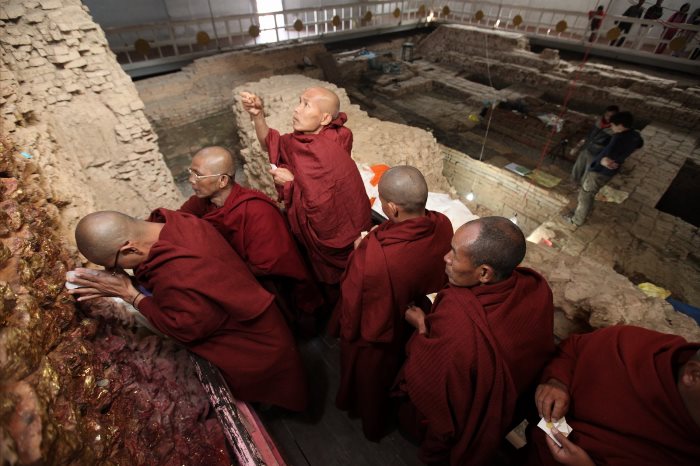Stirling professor part of archaeological discovery confirming early date of Buddha’s life

A University of Stirling professor is part of an international team of archaeologists to uncover evidence of a structure at the birthplace of the Buddha in Nepal dating to the sixth century B.C.
Stirling geoarchaeologist Professor Ian Simpson joined the team led by Durham University Professor Robin Coningham and Kosh Prasad Acharya of the Pashupati Area Development Trust in Nepal.
Their findings, which have been hailed by UNESCO and by the Nepal Government, are the first to link the life of the Buddha to a specific century and to the nativity story.
Pioneering excavations within the Maya Devi Temple at Lumbini, a UNESCO World Heritage site long identified as the birthplace of the Buddha, uncovered the timber structure under a series of brick temples.
It contains an open space in the centre and further geoarchaeological tests confirmed the presence of ancient tree roots within the temple’s central void. According to Buddhist tradition, Queen Maya Devi, the mother of the Buddha, gave birth to him while holding on to the branch of a tree within the Lumbini Garden.
“It was very much a team effort,” explained Professor Simpson, Head of Stirling’s School of Natural Sciences. “We worked very closely with the archaeologists and once they had excavated, we would take samples for dating. We carried out a whole range of different tests and were able to show, for example, that the temple area had been open-roofed.
“It’s an absolutely fantastic project and a true privilege to work not only on a world heritage site, but one of such major religious significance. It really was a unique experience and in relation to understanding Buddhism, its origins and development, the findings are hugely significant. I’m really grateful to Durham University and to colleagues in Nepal and at UNESCO for the opportunity.”
Stirling has a unique soils and sediment sampling facility which supports archaeological sites and landscapes. It has played a key role in projects worldwide including investigating the Neolithic Era in Iran, early cultural sites in Sri Lanka and Viking settlements in the North Atlantic.
Professor Simpson carried out three field trips to Lumbini over the past three years, testing fragments of charcoal and grains of sand to date the findings. Lumbini is one of the key sites associated with the life of the Buddha and the Maya Devi temple remains a living shrine where archaeologists work alongside meditating monks, nuns and pilgrims.
Half a billion people around the world are Buddhists, and by 2020, some 22 million Buddhist pilgrims are expected in South Asia, with many hundreds of thousands making an annual pilgrimage to Lumbini.
Their peer-reviewed findings are reported in the December 2013 issue of the international journal Antiquity and a documentary Buried Secrets of the Buddha will premiere in February internationally on National Geographic Channel.
The archaeological investigation was funded by the government of Japan in partnership with the government of Nepal, under a UNESCO project aimed at strengthening the conservation and management of Lumbini. Along with the National Geographic Society, the research was also supported by Durham University and the University of Stirling.
